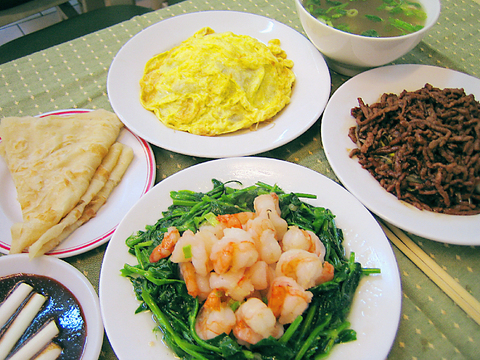You can find beef noodles and potstickers on every corner in Taipei, but if you're looking for a more specialized sampling of northern cuisine, head to the corner of Yitong Street and Songjiang Road's Lane 123.
There you'll find Zhong Fu Yuan, a 22-year-old establishment offering a selection northern (or, more specifically, northeastern) Chinese dishes. The restaurant specializes in something that never gets old -- wrapping stuff up and eating it with your hands. The key element of this process is the jin bing (
The jin bing are made in an area at the front of the restaurant surrounded by windows so you can observe the process. A ball of dough, dripping with vegetable oil, is pulled into a long snake and coiled around into a pile, then rolled flat and plopped on a greasy griddle. Once cooked, the jin bing is slapped around a bit to make it fluffier.

PHOTO: MEREDITH DODGE, TAIPEI TIMES
"Pretty much anything on our menu can be wrapped up in a jin bing," said Chang Kuchiang (章可強), one of Zhong Fu Yuan's managers. It's like the northerner's answer to white rice -- it goes with every dish. Two of the favorite things to put inside a jin bing, however, are shredded pork (or beef) stir-fried in sweet bean sauce (京醬肉絲) and vegetables covered with an egg blanket (合菜代瑁), containing mostly been sprouts.
Some other menu highlights are the beef soup, a savory broth with chunks of meet in the bottom, and the shredded chicken with lapi (
With its selection of hard-to-find, traditional northern dishes, you'd think Zhong Fu Yuan would be run by a family from northern Chinese city. The restaurant's founder, Liu Xiu-xiong (

June 2 to June 8 Taiwan’s woodcutters believe that if they see even one speck of red in their cooked rice, no matter how small, an accident is going to happen. Peng Chin-tian (彭錦田) swears that this has proven to be true at every stop during his decades-long career in the logging industry. Along with mining, timber harvesting was once considered the most dangerous profession in Taiwan. Not only were mishaps common during all stages of processing, it was difficult to transport the injured to get medical treatment. Many died during the arduous journey. Peng recounts some of his accidents in

“Why does Taiwan identity decline?”a group of researchers lead by University of Nevada political scientist Austin Wang (王宏恩) asked in a recent paper. After all, it is not difficult to explain the rise in Taiwanese identity after the early 1990s. But no model predicted its decline during the 2016-2018 period, they say. After testing various alternative explanations, Wang et al argue that the fall-off in Taiwanese identity during that period is related to voter hedging based on the performance of the Democratic Progressive Party (DPP). Since the DPP is perceived as the guardian of Taiwan identity, when it performs well,

A short walk beneath the dense Amazon canopy, the forest abruptly opens up. Fallen logs are rotting, the trees grow sparser and the temperature rises in places sunlight hits the ground. This is what 24 years of severe drought looks like in the world’s largest rainforest. But this patch of degraded forest, about the size of a soccer field, is a scientific experiment. Launched in 2000 by Brazilian and British scientists, Esecaflor — short for “Forest Drought Study Project” in Portuguese — set out to simulate a future in which the changing climate could deplete the Amazon of rainfall. It is

The Taiwan People’s Party (TPP) on May 18 held a rally in Taichung to mark the anniversary of President William Lai’s (賴清德) inauguration on May 20. The title of the rally could be loosely translated to “May 18 recall fraudulent goods” (518退貨ㄌㄨㄚˋ!). Unlike in English, where the terms are the same, “recall” (退貨) in this context refers to product recalls due to damaged, defective or fraudulent merchandise, not the political recalls (罷免) currently dominating the headlines. I attended the rally to determine if the impression was correct that the TPP under party Chairman Huang Kuo-Chang (黃國昌) had little of a